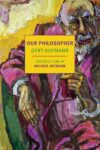
[NYRB; 2023]
“It is disappointing in a way, at last penetrating one of the pockets of life you don’t know and finding that it’s nothing but a part of ordinary life.” So reflects Meg Bailey, the protagonist of memoirist Diana Athill’s only published novel, Don’t Look at Me Like That, upon her first visit to a London nightclub. She’s there with Dick, her best friend Roxane’s husband, who, from this night forward, becomes Meg’s lover. The novel follows the trajectory of Meg’s young life—a dreary patronage upbringing, art school, moving to London, establishing a career, falling in love—while conveying a mingled sense of disappointment and surprise which accompanies much of her experiences.
While the novel follows a turbulent decade in Meg’s life and clocks in at a slim 187 pages (not counting an afterword by Helen Oyeyemi), Meg’s inertia somehow makes the novel feel almost plotless. “Nothing happened. It was shocking to sit there and discover, gradually, that nothing was going to happen—interesting, too, as though I were meeting myself and finding that I was a stranger.” These are Meg’s thoughts the first time she interacts with Roxane after embarking on the affair with Dick. Meg is perpetually shocked by her own capacity for inaction, though not necessarily bothered by it.
The novel serves as an intriguing exposition of the thin dividing line between the ordinary and the extraordinary. Even the bohemian life Meg lives apart from Dick, punctuated by a flourishing illustration career and a bevy of romantic suitors, is painted in ordinary strokes. Meg’s life is lived abstractly, and she remains, ultimately, as much of a stranger to the reader as to herself, which makes for a disarming reading experience.
Things come to a seeming head when Roxane’s meddling mother discovers the affair and resorts to contacting Meg’s parents, leading her abashed but well-meaning clergyman father to turn up in London, pleading with her to return home. Like all of the book’s emotionally intense moments, Meg finds the scene with her father downright intolerable, and yet, of course, it passes, without leaving much of a mark. As soon as Dick turns up at Meg’s flat two weeks later, they continue the affair.
So it was, and went on being, as though nothing had happened. I had loved—still loved—a man, which was supposed to be the climatic event of my life, and it had made no difference to my getting up in the morning, waiting for buses, working, meeting people, coming home to bed, being lonely. I had learnt that the man was not worth loving and it hadn’t stopped me from loving him.
Meg never offers a defense of Dick or tries to convince her reader why she goes back to him. Even at the height of their passion, she doesn’t betray the lover’s impulse to explain or to justify the worthiness of the loved object. There’s no expectation that love or attraction will make any sort of sense; it remains a kind of dazing externality. In practice, though, this leaves Dick’s characterization fuzzy, a partially filled in sketch.
In having Meg dispense with many of the fantasies and illusions that sustain ordinary life, Athill suggests that we don’t know why we do the things we do. The explanations we offer ourselves are a form of comfort, rather than of genuine understanding. Reflecting on her disinterest in therapy, Meg thinks: “I knew that if anything could make me mad it would be someone rummaging in my subconscious and dragging out all kinds of disgusting horrors—why does a mind have a subconscious if it’s not for keeping things hidden?” Meg is not one to plumb her own depths or seek explanations for her behavior. This makes for an intriguing narrative conundrum, because what is narrative but the pursuit of exactly such explanations? There is something inherently frustrating about a protagonist who refuses to explain herself, but it is a generative frustration. If Meg is not invested in coherence, one might ask, why should we be?
To my mind, these questions only become truly interesting at the novel’s end, with the most unexpected development of all: the arrival of happiness. The fact that this event coincides with Meg’s decision to keep Dick’s baby (though their affair finally comes to an end) raises interesting questions about the novel’s relationship to conventionality. Meg doesn’t experience an active desire for motherhood; instead, she finds herself unable to follow through on her choice for an abortion. Once again, inactivity defines the course of events.
“The most surprising thing about happiness was that it seemed natural. It should have been almost shocking after so many meaningless years and the last months of misery, but day by day it became clearer that it was my element.” Part of the surprise of happiness is that it is as senseless as apathy or misery. The shame is that despite Meg’s resistance to narrative, the novel itself remains narratively conventional: happiness is the destination which signals that we’ve arrived at the novel’s end, so just when Meg’s inertia finally alchemizes into something new and compelling, it’s all over.
Mathilde Hjertholm Nielsen holds a Master’s in English and Comparative Literature from Columbia University where she wrote her thesis on the relationship between eternity and film in early twentieth century literature. She is currently living and working at the Wellstone Center, a writing retreat among the redwoods in Santa Cruz, California.
This post may contain affiliate links.







